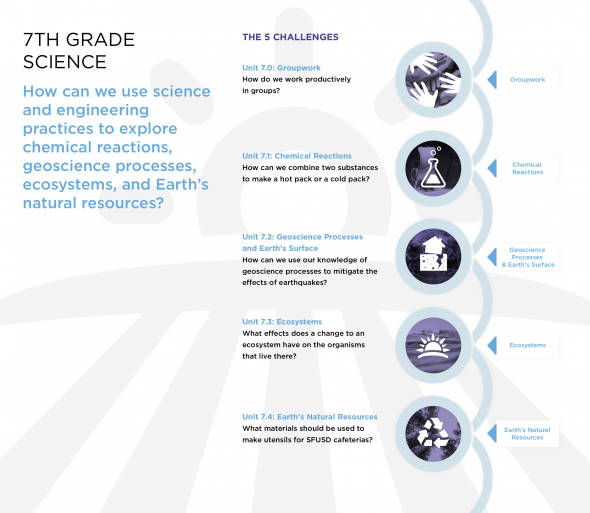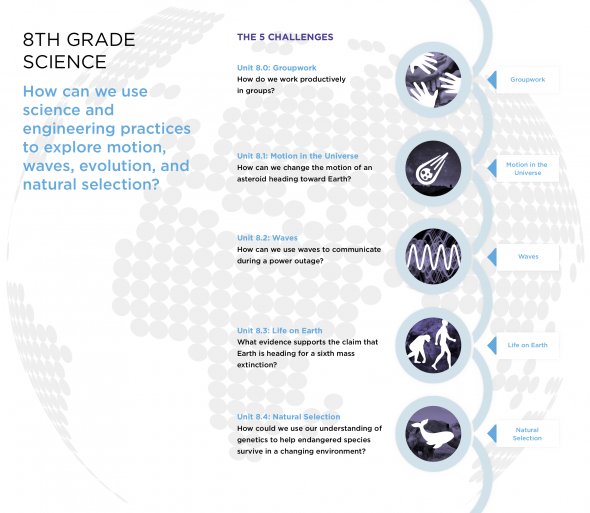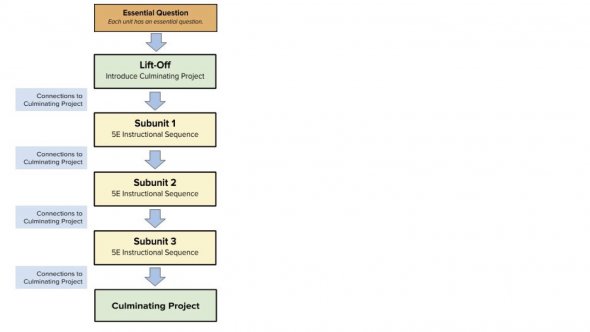Curriculum Design Link to this section
Design Principles Link to this section
The SFUSD Science Middle Grades Core Curriculum emerged from the Learning Through Performance project developed in collaboration with Stanford and the George Lucas Educational Foundation. It is 6th, 7th and 8th grade curriculum in science aligned with the Next Generation Science Standards (NGSS). The model embraces the strengths of project-based learning as an effective instructional model, incorporates rigorous curriculum-embedded performance assessments, enhances student engagement in the learning process, and provides all students with access to learning using research-based groupwork strategies.
The curriculum was designed to reflect the NGSS preferred integrated progression for middle school in which the Performance Expectations for Life Science, Earth and Space Science, Physical Science, and Engineering Design are integrated throughout
In addition to being project-based, the curriculum in 6th, 7th, and 8th grades use a 5E Instructional Model in which teaching and learning proceeds through five different lessons: Engage, Explore, Explain, Elaborate, and Evaluate. Using the 5E Instructional Model allows students to access their prior knowledge and to connect past learning experiences to the present. Students have the opportunity to ask questions and define problems about the natural and designed world; design investigations in which they collect and analyze trends and patterns in their data; develop models of physical phenomena; and communicate findings from their investigations. This curriculum emphasizes the use of engineering solutions and evidence-based reasoning for scientific explanations to communicate recommendations to address real-world problems.
The units are based on the design principles of project-based learning from the Buck Institute for Education. Specifically, the units strive to create well-designed projects that require students to do the following:
- Tackle issues of importance to them beyond the classroom and to adults in the community. Answer the age-old student question “Why do we need to know this?”
- Actively engage in their learning and make important choices during the projects. Projects enable student choice and creativity while still demanding student mastery of essential content, allowing students and teachers to interact as co-learners in the experience rather than in the traditional student-teacher relationship.
- Demonstrate in tangible ways that they have learned key concepts and skills. The Culminating Projects provide opportunities for students to produce observable evidence indicating that they have mastered rigorous curricular standards as they apply their learning and solve the problem at hand. Culminating Projects also provide extensive evidence of process work and self-directed learning.
For the embedded performance assessments within each unit, the science team focused on the following key principles:
- Align to the NGSS. The performance assessments were designed to follow the NGSS Integrated Sequence of Standards and to reflect a careful examination of what teachers want to know about students’ content knowledge, discipline-specific practices, and 21st-century skills.
- Represent authentic and core practices in the discipline. The performance assessments emphasize the key content and practices that are core to the discipline.
- Use rigorous discipline-specific rubrics to score student work. The rubrics identify the key disciplinary content and/or practices and ensure a strong match or alignment between the learning standards, how to evaluate those standards, and what students will be asked to demonstrate in the performance assessments.
- Make assessments engaging to students. The performance assessments focus on students: The goal is to create a relevant and meaningful educational experience for students. Assessment is an integral part of the learning process for both students and teachers.
- Provide opportunities for all students to access the information. The performance assessments provide students with multiple stimuli such as texts, diagrams, data, graphs, pictures, videos, and podcasts to ensure that all students have access to the information and that, when possible, they are presented with options for demonstrating their learning.
- Require students to apply and demonstrate their knowledge and thinking skills. The performance assessments provide students and teachers with valuable group- and individual-level information about what students know and can demonstrate within a specific discipline.
- Provide students with opportunities to receive feedback and make revisions. There are opportunities for self-assessment and peer and teacher feedback. Students are encouraged to revise their work.
- Allow students and teachers to monitor learning and progress over time. Analysis of the assessment data can provide students and teachers with rich information to gauge students’ current knowledge and skills. Understanding students’ gaps in content or skill development helps guide teacher instruction and provides students with feedback to help them master the next performance level.
The curriculum relies heavily on groupwork. It uses a framework developed by the Program for Complex Instruction at Stanford University to inform the construction of group tasks. Multiple research projects conducted by the Program for Complex Instruction show that increased learning gains are directly proportional to the level of students’ on-task talk while working in small groups. Specific strategies are employed within this groupwork strategy that enhance the level of student engagement and talking. Students are given roles that help equalize participation within the groups and require students to be more active learners. The activities are open-ended and productively “ill-structured”—meaning that there are no step-by-step procedures for students to follow. This open-ended structure allows for multiple “correct” answers, and/or methods for arriving at an answer, and requires students to make choices and determine how the group will accomplish the work. Teachers take on the role of facilitators and content coaches who continuously focus on how well groups interact, probe and challenge students’ thinking during the activities, and monitor students’ learning throughout the process.
At each grade level, the Learning Through Performance Science Curriculum consists of five units: four project-based learning units, with embedded performance assessments aligned with the Next Generation Science Standards, and an opening unit, Groupwork, that teaches students how to work as a team. Each unit is organized around a Unit Essential Question.
How can we use science and engineering practices to explore energy, climate, body systems, and the growth and reproduction of organisms?
Unit 6.0: Group work
How do we work productively in groups?
Unit 6.1: Energy
How can we design a device to warm something up?
Unit 6.2: Human Impact on Earth’s Climate
What are the effects of global temperature rise on San Francisco Bay and what can we do about it?
Unit 6.3: Cells and Body Systems
Should SFUSD ban caffeine? Why or why not?
Unit 6.4: Reproduction and Heredity
How can we design a new park that supports the growth and reproduction of plants?

How can we use science & engineering practices to explore chemical reactions, geoscience processes, ecosystems, and Earth's natural resources?
Unit 7.1: Chemical Reactions
How can we combine two substances to make a hot pack or a cold pack?
Unit 7.2: Geoscience Processes and Earth's Surface
How can we use our knowledge of geoscience processes to mitigate the effects of earthquakes?
Unit 7.3: Ecosystems
What effects does a change to an ecosystem have on the organisms that live there?
Unit 7.4: Earth's Natural Resources
What materials should be used to make utensils for SFUSD cafeterias?

How can we use science and engineering practices to explore motion, waves, evolution, and natural selection?
The 5 Challenges
Unit 8.0: Group work
How do we work productively in groups?
Unit 8.1: Motion in the Universe
How can we change the motion of an asteroid heading toward Earth?
Unit 8.2: Waves
How can we use waves to communicate during a power outage?
Unit 8.3: Life on Earth
What evidence supports the claim that Earth is heading for a sixth mass extinction?
Unit 8.4: Natural Selection
How could we use our understanding of genetics to help endangered species survive in a changing environment?

Anatomy of a Unit
The project-based learning units follow a defined structure. (Unit 0: Groupwork, which prepares students for the kind of work required in the other four units, follows a different structure.)
LIFT-OFF
The goal of the Lift-Off lesson is to capture students’ interest and to provide the foundation for the content and practices they learn throughout the unit. The Lift-Off lesson also introduces students to the Culminating Project and the criteria used to evaluate the project. Thus, from the beginning of each unit, students know what project they will complete and how they will be evaluated for both the group and individual components of the project.
SUBUNITS 1–3
Each unit is divided into three subunits that were designed using the 5E Instructional Model. In this model, teaching and learning proceeds through five different lessons: Engage, Explore, Explain, Elaborate, and Evaluate. The lessons provide a series of common learning experiences that may include laboratories or investigations, simulations, research, field trips, guest speakers, and discussions. These learning experiences support students’ learning of the facts, concepts, and skills central to the unit goals and successful completion of the Culminating Project. While completing the learning experiences, students may produce interim work products or complete benchmark assignments that serve to scaffold their completion of the Culminating Project. These are scored or evaluated using common rubrics.
CULMINATING PROJECT
The Culminating Project is a rich, performance-based task that serves as the ultimate goal of the project-based learning unit. There is a Group and an Individual Culminating Project in each of the four project-based learning units. For the project, students complete a product or provide a demonstration of their content understanding and skill. The Culminating Project serves as one measure of students’ mastery of the facts, concepts, and skills that they learn throughout the unit. The Culminating Project is designed to tap into applications of learning and higher-order thinking that cannot be measured in other ways. Students may also be expected to participate in an exhibition to demonstrate their learning before an audience such as their parents or fellow students. Both the Culminating Project and the exhibition are scored using common rubrics.
Unit Structure
Link to this section
The project-based learning units follow a defined structure. (Unit 0: Groupwork, which prepares students for the kind of work required in the other four units, follows a different structure.)
LIFT-OFF
The goal of the Lift-Off lesson is to capture students’ interest and to provide the foundation for the content and practices they learn throughout the unit. The Lift-Off lesson also introduces students to the Culminating Project and the criteria used to evaluate the project. Thus, from the beginning of each unit, students know what project they will complete and how they will be evaluated for both the group and individual components of the project.
SUBUNITS 1–3
Each unit is divided into three subunits that were designed using the 5E Instructional Model. In this model, teaching and learning proceeds through five different lessons: Engage, Explore, Explain, Elaborate, and Evaluate. The lessons provide a series of common learning experiences that may include laboratories or investigations, simulations, research, field trips, guest speakers, and discussions. These learning experiences support students’ learning of the facts, concepts, and skills central to the unit goals and successful completion of the Culminating Project. While completing the learning experiences, students may produce interim work products or complete benchmark assignments that serve to scaffold their completion of the Culminating Project. These are scored or evaluated using common rubrics.
CULMINATING PROJECT
The Culminating Project is a rich, performance-based task that serves as the ultimate goal of the project-based learning unit. There is a Group and an Individual Culminating Project in each of the four project-based learning units. For the project, students complete a product or provide a demonstration of their content understanding and skill. The Culminating Project serves as one measure of students’ mastery of the facts, concepts, and skills that they learn throughout the unit. The Culminating Project is designed to tap into applications of learning and higher-order thinking that cannot be measured in other ways. Students may also be expected to participate in an exhibition to demonstrate their learning before an audience such as their parents or fellow students. Both the Culminating Project and the exhibition are scored using common rubrics.
Alignment and Looping
Link to this section
Alignment and Looping
The following is a breakdown of the dimensions of the Next Generation Science Standards (NGSS) that are explored in each unit of this three-year middle school curriculum for students in grades sixth through eight. Students engage in three dimensional science learning by asking questions, designing investigations, and using evidence-based reasoning to address personally relevant and environmentally focused challenges. The “looping” process refers to the learning opportunities that students have to preview or review topics in order to deepen their evolving understanding of core NGSS concepts over time.
The project-based learning units follow a defined structure. (Unit 0: Groupwork, which prepares students for the kind of work required in the other four units, follows a different structure.)
NGSS Performance Expectations (PEs)
Disciplinary Core Ideas (DCI)
Crosscutting Concepts (CC)
Science and Engineering Practices (SEP)
Educators outside SFUSD Link to this section
SFUSD's Middle School Science Core Curriculum is now available online to educators outside San Francisco Unified School District. If you would like access to it, please contact Priscilla Perez at perezp2@sfusd.edu.
The Middle School Science Team Link to this section
Priscilla Perez: perezp2@sfusd.edu
This page was last updated on August 15, 2025





